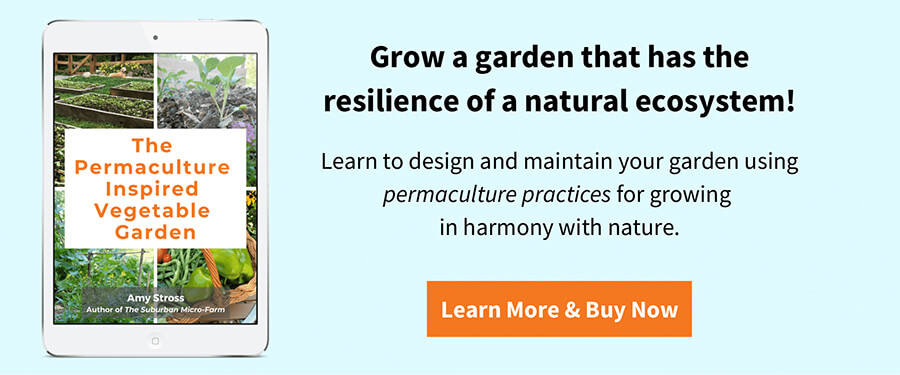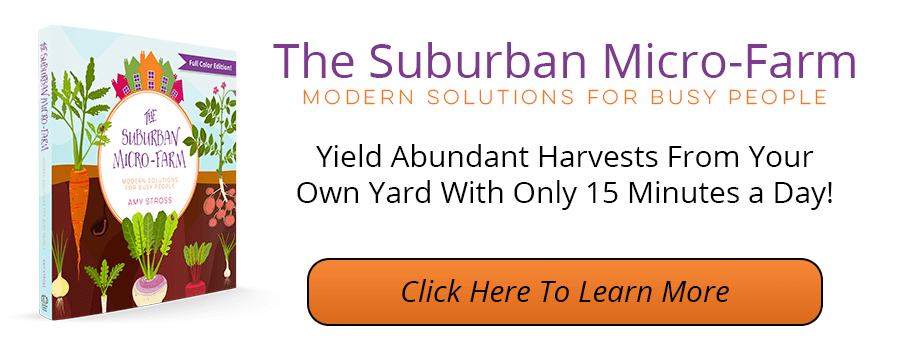Does it seem overwhelming to start a homestead from scratch? This guide will help you bust through doubt and discomfort to achieve your dreams.

This page may contain affiliate links. Please read my disclosure for more info.
In this article:
- Why accepting feedback is important for homesteading success
- Books that can help you get started with homesteading
- Helpful online resources for beginning homesteaders
- Why it’s important to know your growing season
- Why you should start with a small homestead garden
- How a homestead mentor or buddy can help
- Why financial stability is important for homesteading
- 4 FAQs about starting a homestead without the overwhelm
Years ago when I quit my job as a high school teacher, I fell in love with growing my own food. You could say that it was my gateway drug to homesteading! I quickly discovered that there was a whole world beyond just growing my food.
Along my journey to start a homestead, I’ve discovered all kinds of ways to become more self-sufficient. For example, I could use what I was growing for fresh eating, preserving for winter, and for making medicinal and personal care products.
Creating a homestead empowered me to produce more with the space I had available to me and it inspired me to have a deeper connection with my home.
But the journey hasn’t been a straight line. The more skills I learned, the more I felt inadequate, like I wasn’t doing enough. I felt overwhelmed by it all.
The following are some tips for enjoying your journey to create a productive homestead, and sticking with it.
1. Accept Feedback
When I was getting started, I didn’t know a single person who was homesteading or working to create a productive homestead. Here’s my story of how I started homesteading.
Since those early years of my journey, the homesteading concept has become more popular. More and more resources and communities (both online and in-person) are available to support you in the process. This is so great!
One of the first things I learned is to accept feedback. This means I had to pay attention to the different things I was trying around the homestead and evaluate how they were working. Sometimes I really wanted something to work, but the writing on the wall was that it wasn’t a good solution.
Accepting failure as a means of learning is key. And normal. You will fail, but it doesn’t mean you weren’t cut out for this kind of life.
The same thing goes for gardening. I hear people say all the time, “I don’t have a green thumb.” Gardening failure isn’t an indication of the color of your thumb. The key to becoming a ‘green thumb’ garden expert is simply practice.
Practice the craft just like you would practice playing the guitar, and learn from your mistakes. See: Want to Be a Micro-Farmer? 6 Tips for Success (And 6 Things Not To Do)
Eventually you’ll hit the right notes and be able to play with some efficiency. The key to getting started, then, is to just start, and to keep doing and learning.

2. Become a Perpetual Student
When I started this life, I had no idea that I would be constantly learning. I figured I would learn how to garden and preserve food, for example, and that would be it: Bam, I’m now a veteran homesteader!
Things don’t quite work out that way. Turns out that no one grows beets in the same soil in the same place on earth with the same climate and the same sun exposure. So I’ve learned to be my own researcher.
I read and listen to other gardeners, glean useful advice that might help me with my [beet growing] failure, and I try again.
Incidentally, did you know that starting a homesteading life as an adult can actually be good for the longevity of your brain? This lifestyle seriously gives your brain lots of things to mull over!
Would you like to grow more food with less effort? Check out my mini guide, The Permaculture Inspired Vegetable Garden.
Take the winter months to read things that interest you.
No two homesteaders are exactly alike. Some can’t wait to get backyard livestock, some are excited to start a small garden, and some want to create an integrated permaculture food forest.
There are still others who don’t keep a garden or animals at all, but rather focus on fiber arts, or from-scratch cooking and preserving, or making their own household cleaners and toiletry items.
Hint: You can’t do it all! Pick a few things to do really well.
Resources abound to help you on your journey no matter what homesteading topics get you excited. If you don’t know what to focus on, read a lot of different things so you can identify your passions.
The following are some resources to simply get your feet wet. There’s so much information out there that it isn’t possible to list all of the great resources!
Book List for Beginners (Other than my own!)
- Gaia’s Garden: A Guide to Home-Scale Permaculture (permaculture)
- The Backyard Homestead Guide to Raising Farm Animals (livestock)
- The Urban Homestead (for the small-scale homestead)
Helpful Online Resources for Beginners
Homesteading:
- Start Homesteading Today with These Hacks (And Little to No Money) by The Frugal Chicken
Gardening:
- 11 Tips for Beginning Gardeners by The Free Range Life
- Square Foot Gardening for Beginners by The Cape Coop

Take classes and tours.
Read all you can, but there is no comparison between reading a book (one-way learning) versus interactive learning with real, live humans. Take classes and attend farm/homestead tours to catapult your knowledge and confidence.
Here’s how to choose the right permaculture design course.
3. Get Acquainted with Your Growing Season
How a garden changes throughout the year—what can be planted or harvested—will depend on the climate and a number of other factors. In fact, even two gardens in the same zip code can experience slight differences!
To plan a better garden, get in tune with your seasonal growing cycle. Here’s what I do monthly in my garden.
It’s okay if you don’t grow everything you eat. Practice eating seasonally by shopping your local farmer’s market at least once a month to learn about what’s in season in your area.
Growing healthy food is what local farmers do best, and eating healthy food is what you should do best (Don’t skip the eating part!).
Would you like to learn more about creating a vibrant homestead garden that takes only 15 minutes a day to maintain?
You’ll find loads of information just like this in my award-winning book, The Suburban Micro-Farm.
4. Start Small
If you want to get overwhelmed, discouraged, and burned out, try turning your entire property into a garden in your first year! 🙂 Gardens look simple and quaint on paper, but maintaining them can be hard work.
My philosophy: Start with one garden bed and see how it goes. Set a goal to spend at least 15 minutes each day in the garden. This way you can learn how a garden changes from day to day. You’ll also introduce gardening into your day-to-day routine.
Expand as you find success with your small garden.

5. Find a Mentor or a Homestead Buddy
Homesteading and gardening will challenge you mentally and physically. A mentor can guide you through the ups and downs and successes and failures. Meanwhile, a buddy is essential for commiserating when the squirrels eat all your tomatoes!
6. Make Your Kitchen a Working Kitchen
Making a house a productive homestead is a lot of work.
Growing your own food is a big job. You know what else is a big job? Making from-scratch meals and preserving the excess.
Start small in the garden so you have the time and space to add new food-prep skills to your repertoire.
7. Get Out of Debt and Start Saving
Living a self-sufficient lifestyle is only possible if debts are out of the picture and a bit of money is saved for emergencies. This ensures that you don’t have to worry when the going gets tough. Dave Ramsey’s Total Money Makeover was a huge blessing in our life.
We would never have been able to save for our dream homestead if we hadn’t followed his plan to get out of debt. Be prepared: This is a long-term goal—no instant gratification here!
Eating good food is essential for health, and you’ll need good health for the physical and mental demands of starting a homestead. But good food can be expensive. Learn how to save, budget, and make do while you follow your dreams!
Starting a new homestead can seem overwhelming, but it can be done, even on a busy schedule with a tight budget. Start small, enjoy the learning process, and celebrate the small successes. You’ll have a productive homestead in no time!
FAQs About Starting a Homestead Without the Overwhelm
#1: How do I start a homestead without being overwhelmed?
Starting a homestead is all about learning as you go. Accept feedback, be willing to make mistakes, start small, and expand as you gain confidence.
#2: What’s the best way to learn homesteading skills?
Become a perpetual student! Read books, follow online resources, and take classes or homestead tours to gain hands-on experience. Learning from others and experimenting on your own will help you grow your skills over time.
#3: How can having a mentor or homestead buddy help me?
A mentor can guide you through the ups and downs and successes and failures, and a buddy is essential for commiserating with when the squirrels eat all your tomatoes!
#4: Why is financial stability important for homesteading?
A self-sufficient lifestyle is easier when you’re not burdened by debt and have money saved for emergencies. This also allows you to invest in your homestead without stress.
Do you have any tips for starting a homestead?
READ NEXT:







Seth says
As a recent college grad, I still have a good amount of debt to pay off. But that’s not gonna stop me from planning my future homestead.
I’m still always looking for free land, and researching the best ways to start!
Thanks for the article.
Nkosinathi Makoba says
I have a task to start a new life project soon in the middle of nowhere. This article couldn’t have come at a better time.
Julia Johnson says
This was wonderful – thank you so much! My husband and I have been so eager to start our homestead, but are a little anxious working out the kinks. From location to loans to finding a space big enough for cows, its been a lot so far.
This article helped a TON! Thank you especially for the book list and recommendations!